Chicken Rolls Stuffed with Vegetables is a very visually attractive dish. Colourful vegetables are placed in the centre of the chicken roll. The sweet teriyaki sauce coating the chicken makes this dish so tasty.
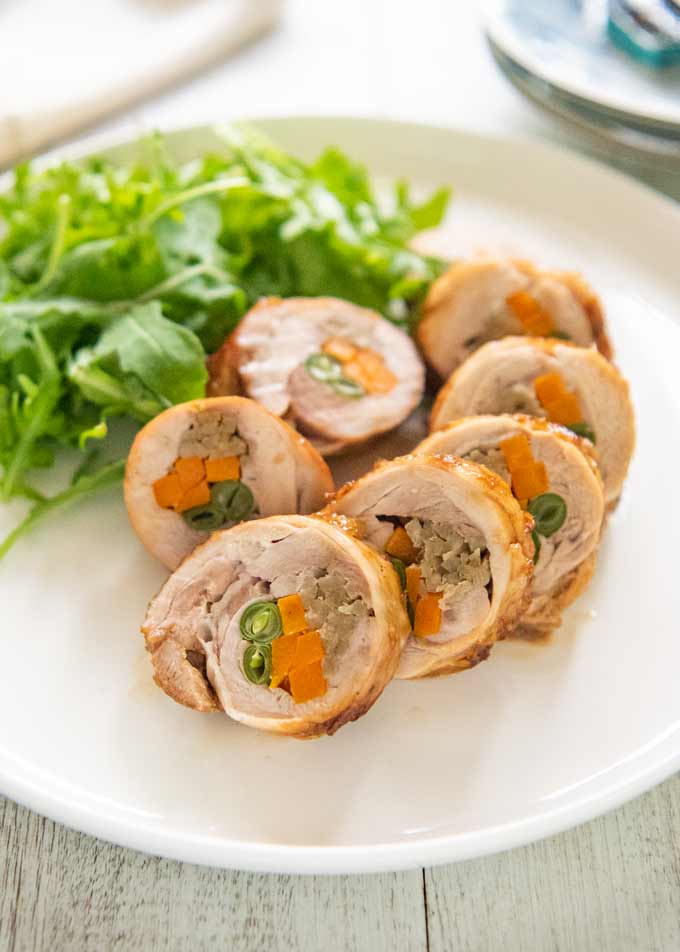
Chicken Rolls Stuffed with Vegetables is often served at New Year’s feasts. The original dish, Yawata-maki, is made with either eel or conger eel fillet, instead of chicken. Burdock sticks are wrapped in eel fillets and cooked with a sweet soy-flavoured sauce.
About Yawata-maki
The traditional Yawata-maki (八幡巻) is a local specialty of Yawata city in Kyoto. The name of the dish came from the fact that Yawata district is famous for burdock as well as wild-caught eel.
Since eel became quite an expensive ingredient and handling of eel is also difficult, people started using sliced beef or chicken fillet, instead of eel. If you Google search images of Yawata-maki in Japanese, you will find that most of them use either beef or chicken instead of eel.
To make the dish more appealing, colourful vegetables are also added. A typical combination of vegetables is burdock, carrot, and green beans, which is exactly what I used in my recipe.
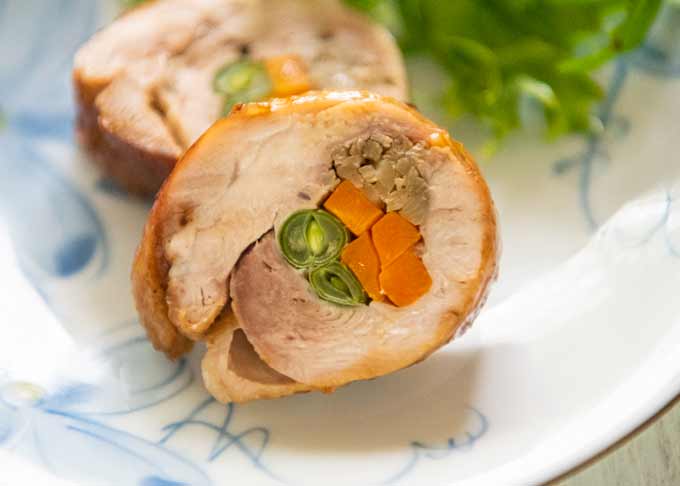
You don’t have to have all these vegetables. People often use just burdock to be close to the original Yawata-maki. You can just have two kinds of vegetables, e.g., burdock and carrot.
To call it Yawata-maki, you need to include burdock. If you use beef slices to roll the vegetable, the dish is called ‘gyūniku no Yawata-maki’ (牛肉の八幡巻). If chicken fillet is used, it is called ‘toriniku no Yawata-maki’ (鳥肉の八幡巻). ‘Gyūniku’ means beef and ‘toriniku’ means chicken fillet.
What is in my Chicken Rolls Stuffed with Vegetables
In addition to the meat and vegetables, you need two different sauces – the sauce to pre-cook vegetables and the sauce to add flavour to the chicken rolls, which I call ‘tare’.

Meat and Vegetables
- Boneless whole chicken leg (chicken Maryland in Australia, chicken quarter in the US)
- Burdock cut into sticks
- Carrot cut into sticks
- Green beans, stems removed
My whole chicken leg came with bones, so I had to debone it myself. Where I live, it is not easy to find a chicken leg fillet. I think chicken leg works better than breast as the leg fillet is juicier when cooked, but you can use a large breast fillet instead. You need to butterfly the breast fillet as it is otherwise too thick and small to roll.
I could not find a fresh burdock root since it is not in season here in Australia, so I used frozen burdock sticks that were cut for Kinpira Gobō.
As mentioned in the previous section, you don’t need to have all the vegetables listed here. But these are by far the most commonly used vegetable combination for this dish.
The photo below is the chicken rolls I made with parsnip (instead of burdock), carrot and green beans. The parsnip was a bit bitter compared to burdock, but the appearance is similar when cooked.

Simmering Sauce for Vegetables
Because the flavouring for the chicken is added at the end after rolling the vegetables inside the chicken, some vegetables need to be pre-cooked with a simmering sauce.
- Dashi stock
- Soy sauce
- Cooking sake
- Mirin
Tare (Sauce for Chicken Rolls)
- Soy sauce
- Cooking sake
- Mirin
- Sugar
- Vinegar
I added vinegar to the tare to give a slightly different flavour to the teriyaki sauce used for Teriyaki Chicken. If you prefer, you can use the standard teriyaki sauce.
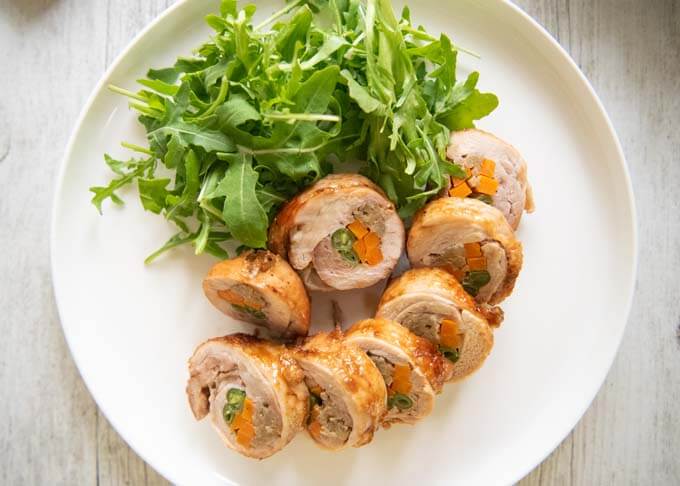
How to Make Chicken Rolls Stuffed with Vegetables
There are many different ways of cooking chicken rolls. In this recipe, I wrapped the chicken rolls in aluminium foil, then baked them in a frying pan with a lid on. Some recipes secure the chicken roll with a butcher’s twine, then brown the surface of the roll. but I think that wrapping the roll in foil keeps the meat moist.
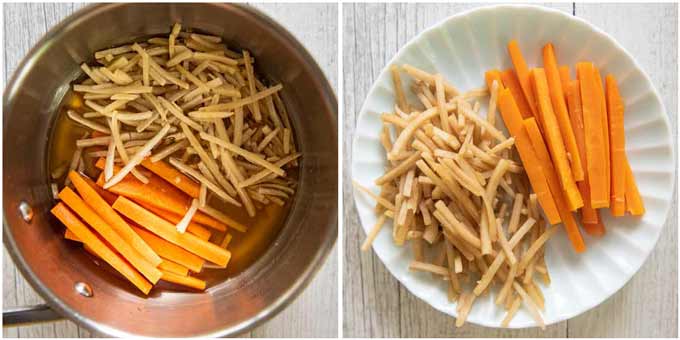
- Cook burdock and carrot sticks in the Simmering Sauce, and blanch green beans.
- Poke the chicken skin randomly with a fork.
- Butterfly the thicker parts of the fillet to even the thickness of the fillet.
- Place the vegetables on the chicken fillet and roll the fillet tightly.
- Wrap the chicken roll in aluminium foil. Twist both ends to secure the wrapping.
- Cook the chicken rolls in a frying pan with a lid on over low heat for 17-20 minutes. Rotate the rolls a couple of times so that you can cook the chicken rolls evenly.
- Turn the heat off and leave the chicken rolls in the pan with the lid on for 20 minutes.
- Remove the foil, add the tare to the pan, then bring it to a boil.
- Roll the chicken rolls occasionally to evenly coat them with the sauce.
- When the sauce is almost evaporated, turn the heat off.
- Slice the rolls into 1cm/⅜” thick pieces and serve.
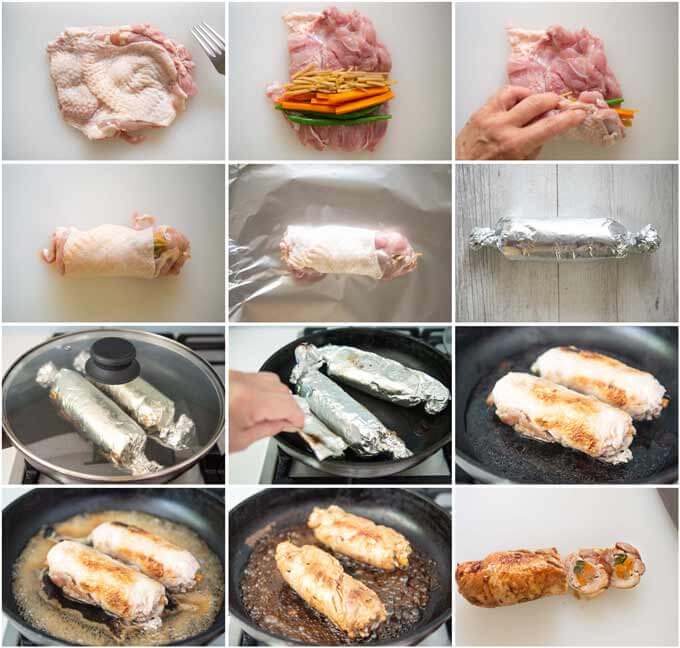
I condensed the tare until it almost evaporated, so that the chicken was coated with a thick sauce. Alternatively, you can turn the heat off earlier leaving some sauce left so that you can pour over the sliced chicken when serving.
Yawata-maki can be served as a main dish, a side dish, or an appetiser. It keeps about 5 days in the fridge, and you can freeze sliced Yawata-maki for up to one month.
Yumiko![]()
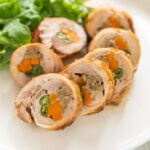
Chicken Rolls Stuffed with Vegetables is a very visually attractive dish. Colourful vegetables are centred and rolled in a chicken fillet. The sweet teriyaki-flavoured sauce coating the chicken rolls makes this dish so tasty.
Don't forget to see the section 'MEAL IDEAS' below the recipe card! It gives you a list of dishes that I have already posted and this recipe that can make up a complete meal. I hope it is of help to you.
- 2 boneless whole chicken legs (skin on, note 1)
- 50g/1.8oz carrot cut into 7mm/¼" thick, 6-7cm/2⅜-2¾” long sticks
- 50g/1.8oz burdock cut into 7mm/¼" thick, 6-7cm/2⅜-2¾” long sticks or 3mm/⅛" thick match sticks (note 2)
- 30g/1.1oz green beans stem trimmed, blanched
- 100ml/3.4fl oz dashi stock
- 1 tsp soy sauce
- 1 tsp cooking sake
- 1 tsp mirin
- 1 tbsp soy sauce
- 1 tbsp cooking sake
- 1 tbsp mirin
- 1 tsp sugar
- 1 tsp vinegar
-
Put Simmering Sauce ingredients, carrot sticks, and burdock sticks in a shallow pot. Put a lid on and bring it to a boil.
-
Reduce the heat to low and cook for about 5 minutes until the vegetables are almost cooked through. Drain and let them cool.
-
Cut the beans to the length similar to the width of the chicken.
-
Randomly poke the chicken skin with a fork. This will allow the sauce to penetrate into the flesh better.
-
Place the fillet on a workbench, skin-side down. Where the meat is thicker than the other parts of the fillet, cut horizontally outward without completely cutting it off so that the top part of the meat opens like butterflying (note 3). This will give the fillet an even thickness.
-
Position the chicken with the drumstick end of the fillet towards you, then place half each of the beans, carrot, and burdock on the fillet closer to you. Spread the vegetables evenly crosswise.
-
Starting from your end of the fillet, roll the fillet tightly with vegetables inside. You may need to push the vegetables back inside on both ends as you roll.
-
Place 2 layers of 30cm/11¾"-long aluminium foil on a workbench and place the chicken roll on one end of the foil.
-
Wrap the chicken in the foil by rolling, twisting both ends of the foil as you roll so that you can prevent the vegetables from getting squeezed out from both ends of the roll. Secure both ends of the foil by twisting and bending.
-
Place the wrapped chicken rolls in a frying pan and place a lid on. Turn the heat on to low and cook for 7 minutes.
-
Turn the rolls about 120 degrees, put the lid back on and continue to cook for 5 minutes (note 4).
-
Turn the rolls about 120 degrees again in the same direction as the first turn and cook another 5 minutes with the lid on (note 4).
-
Turn the heat off and leave for 20 minutes or so, with the lid on.
-
Remove the lid and peel the foil off the chicken rolls in the pan so that you can capture the juice coming out of the chicken in the pan.
-
Mix the Tare ingredients well, ensuring that the sugar is dissolved.
-
Add the tare to the pan with the chicken rolls and turn the heat on to medium.
-
When the sauce starts boiling, roll the chicken occasionally so that the surface of the chicken gets coated with the sauce.
-
Continue to cook until the sauce condenses and the sticky large bubbles start rising, then turn the heat off (note 5).
-
Let the chicken rolls cool down to room temperature.
-
Slice each roll to 1cm/⅜” thick and serve.
1. The whole leg of chicken is called chicken Maryland in Australia, but in the US, it is a quarter chicken, i.e., whole chicken leg with the thigh and the drumstick portion together.
I used fillets of about 250g/0.4lb each with skin on. The skin gives the dish more flavour but fillets without skin is OK too.
Like me, if you can only find a leg with the bone in, I am afraid you will need to remove the bones. Check out one of the YouTube demonstrations of How to Debone a Chicken Leg and Thigh.
You can use breast fillet if you prefer, but the cooked chicken might be a bit dry. You need to butterfly the entire breast fillet by cutting it horizontally so that the fillet becomes thinner and the surface area larger.
2. If you can find a fresh burdock root, that is great. Burdock is not in season where I live at the moment, so I used frozen burdock that was cut into matchsticks suitable for Kinpira Gobō.
3. Try to shape the fillet to become square or rectangle. This makes rolling of the fillet easier.
4. It doesn’t have to be a 120 degree-turn. You just want to turn them so that the surface of the chicken gets cooked more evenly. If you are turning more frequently, the cooking time between the turns need to be reduced, i.e., total cooking time is about 17 minutes.
5. I condensed the sauce until the sauce became sticky. If you prefer, you can turn off the heat earlier, leaving some sauce so that you can pour it over when serving.
6. Nutrition per serving, assuming 4 servings.
serving: 224g calories: 365kcal fat: 23g (35%) saturated fat: 6.7g (34%) trans fat: 0.0g polyunsaturated fat: 5.1g monounsaturated fat: 9.7g cholesterol: 129mg (43%) sodium: 444mg (19%) potassium: 449mg (13%) carbohydrates: 7.9g (3%) dietary fibre: 1g (4%) sugar: 4.4g protein: 27g vitamin a: 68% vitamin c: 9.4% calcium: 2.3% iron: 13%
Meal Ideas
A typical Japanese meal consists of a main dish, a couple of side dishes, a soup and rice. I try to come up with a combination of dishes with a variety of flavours, colours, textures and make-ahead dishes.
I decided to serve Chicken Yawata-maki as a main dish today. It gives you bright colours without adding other dishes, so you can pick dishes purely based on the flavour and texture combinations.
My side dish choices are Renkon no Hasami Age and and Watercress Salad. Soup can be either miso soup or clear soup.
- Main: Chicken Rolls Stuffed with Vegetables (Chicken Yawata-maki) – today’s recipe, make ahead.
- Side dish 1: Deep Fried Lotus Root and Prawn Sandwiches (Renkon no Hasami Age) – you can make ahead and reheat in the oven.
- Side dish 2: Wasabi Dressing and Watercress Salad – or other vegetable dish.
- Soup: Daikon and Aburaage Miso Soup – or other miso soup ingredients of your choice. A clear soup also works fine.
- Rice: Cooked Rice.
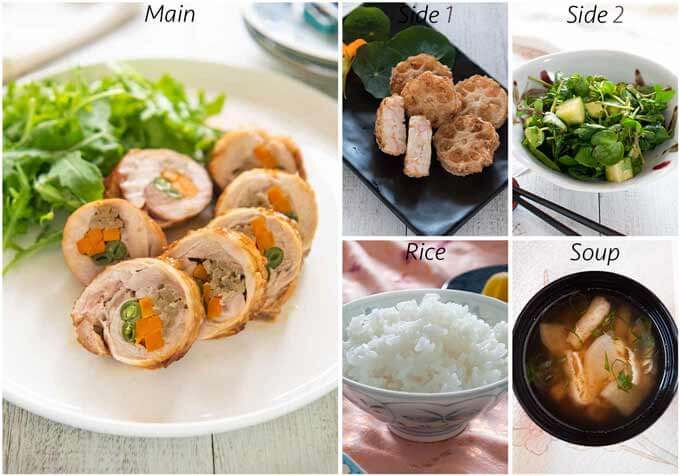
Looks so good, I can’t wait to make it. Thank you for the wonderful recipe.
Hi Jean, thanks! Please do try and let me know.
Thank you for your recipes. This looks so tasty and something the whole family will eat.
Hi Lucy, thank you. Please try and let me know how it wernt.
These were delicious when you served them and I am delighted to have the recipe.
Thank you, Linda!
These look amazing and I can’t wait to try them. Thanks for all your great recipes
Hi Coral, thank you! Please let me know what you think.